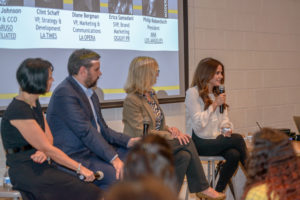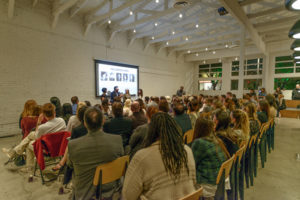
Four of LA’s top marketing and public relations professionals gathered before a capacity crowd at General Assembly in Santa Monica on Wednesday, Oct. 26, to discuss the intersections between their fields at “#BLURREDLINES: Marketing vs. PR.”
The panel, which was co-sponsored by AMA Los Angeles and PRSA-LA, featured Diane Bergman, vice president of marketing and communications at the LA Opera, Judy Johnson, chief marketing and communications officer for Caruso Affiliated, Erica Samadani, senior vice president of brand marketing for Ogilvy Public Relations, and Clint Schaff, vice president of strategy and development for the Los Angeles Times Media Group.
AMA Los Angeles President Philip Rebentisch began the evening by asking the panelists a question designed to kick-start the debate: what’s the difference between marketing and PR?
“Simply put, we don’t buy influence in PR,” Samadani began.
Much to the amusement of the audience, Bergman immediately chimed in, “I disagree completely.”
Schaff offered a working definition to ground the evening’s conversation: “Public relations is more advocacy and building relationships and building trust with the consumers, but marketing is more directly about impacting revenue and sales.”
And Johnson explained how she thinks about the roles on her staff at Caruso Affiliated, an industry leader in real estate development: “I look at my entire team and I feel like public relations and marketing are one team — they have different roles, and sometimes they’re blended, but everybody has a seat at the table, they’re all necessary.”
Rebentisch pressed the panel about some commonly held assumptions on either side of the PR/marketing divide, including a tendency among marketers to circumscribe PR’s role to media relations.
“To say PR is just about media relations is like saying marketing is just about advertising,” Bergman said. “Public relations is about relationships with your many publics, but it also functions as the moral compass of an organization.”
Samadani elaborated, “When you’re in a relationship, you start by listening and understanding someone’s needs, so that’s where PR really comes in, and that’s where we feel we can influence the marketing mix.”
Two areas in which marketing and PR typically blur are social media and content marketing.
Samadani shared Ogilvy’s strategy with client OUE Skyspace, which features a glass outdoor slide on the 70th floor of the US Bank Tower in DTLA. Because of construction, the Ogilvy team didn’t have a finished space to present to the media, so it had to get creative.
The agency drove early buzz on social by hiring a 3-D rendering artist and using Instagram influencers to take breathtaking rooftop images. Earned media didn’t significantly enter the picture until the attraction’s opening in June.
At Caruso Affiliated, Johnson hired a lifestyle influencer to create content that appeals to the fashion-forward inclinations of The Grove’s target customer, which her team identified with market res earch. And for the LA Opera, Bergman hired an “internal journalist” focused on video.
earch. And for the LA Opera, Bergman hired an “internal journalist” focused on video.
“It’s creating the right channel and steering the client in that direction,” Samadani said, “and then making sure that the content that you’re creating is compelling, culturally relevant and authentic.”
To sum things up, Schaff put the issue in terms of objectives and outcomes.
“You go into a room and ask, ‘what’s the outcome of a game of baseball?’ and a lot of people say, ‘Well, the Dodgers win, 6-5.’ But the outcomes are far beyond that,” Schaff said. “The outcomes are: peanut sales, American pride, city pride, President Obama normalizing relations with Cuba at a baseball game. I think whatever discipline we’re in, we’re best served if we can figure out how to be laser-focused on accomplishing objectives, like the marketers, and also open to serendipitous positive outcomes that you can leverage for the benefit of your client, like the PR people typically do.”
And how does this collaboration look in practice? Johnson said it would be false to say there’s not creative or strategic tension.
“I think what you’re hoping is that when you bring people together, different points of view will bring different ideas, and sometimes that’s uncomfortable,” Johnson said. “But at the end of the day, hopefully through some creative strategic discussion, and some vetting — and no hard feelings when you leave the room — everyone’s voice can be heard, and there will be a better product.”
The event was sponsored by TriNet, General Assembly, Mendocino Farms, Erdinger and Just Chill.








